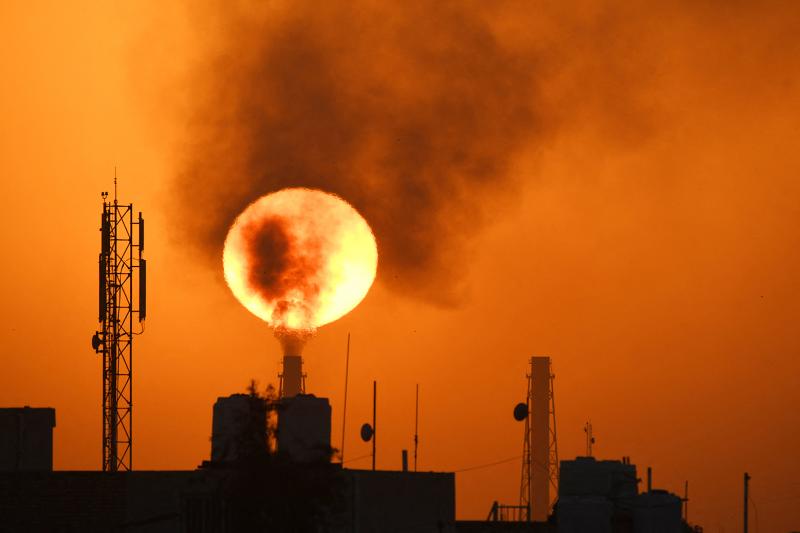Oil in London fell for the first week in two months as signals of a patchy demand rebounded across the globe and a stronger US dollar held back crude’s rally.
Brent crude for May delivery on Friday fell 0.59 percent to US$69.22 a barrel, down 0.2 percent from a week earlier.
West Texas Intermediate for April delivery declined 0.62 percent to US$65.61 a barrel, posting a 0.73 percent drop for the week — its first weekly decline in three weeks.

Photo: AFP
A fresh bout of bond volatility spurred a risk-off mood across markets, with US equities declining and the US dollar strengthening.
Indian fuel sales dipped last month amid higher pump prices, but demand has been climbing in the US and the UK.
“There was this bullish demand scenario out of Asia, in particular India, but that may be plateauing,” said John Kilduff, a partner at Again Capital LLC.
Still, prices “are supported overall, with the OPEC+ disposition to hold back supplies,” he said.
The global Brent benchmark started this week with a push above US$70 after attacks on Saudi Arabia’s oil infrastructure, before retreating. The market is facing opposing forces from OPEC+ holding output steady and higher prices potentially encouraging a surge in US shale production.
“Going forward into April and May, we’re going to see pretty significant increases in demand,” said Bart Melek, head of commodity strategy at TD Securities. “At this point, however, prices are a little overdone. The market is assuming a little too much in terms of what OPEC+ will do.”
The availability of crude remains tight due to the OPEC+ curbs. Some refiners in Europe and Asia are to receive less crude than they asked for next month from Saudi Arabia as the producer extends its unilateral output cuts. Three processors are to receive almost 20 percent less supply than requested.
Meanwhile, the refining margin for gasoline surged above US$24 a barrel for the first time since June 2018 on a settlement basis, with the exception of April when crude prices plunged below zero. The combination of steep gasoline supply declines following refinery outages from the US deep freeze and signs of demand starting to pick up are adding to a tight fuel supply picture heading into the northern hemisphere’s summer.

Taiwan Transport and Storage Corp (TTS, 台灣通運倉儲) yesterday unveiled its first electric tractor unit — manufactured by Volvo Trucks — in a ceremony in Taipei, and said the unit would soon be used to transport cement produced by Taiwan Cement Corp (TCC, 台灣水泥). Both TTS and TCC belong to TCC International Holdings Ltd (台泥國際集團). With the electric tractor unit, the Taipei-based cement firm would become the first in Taiwan to use electric vehicles to transport construction materials. TTS chairman Koo Kung-yi (辜公怡), Volvo Trucks vice president of sales and marketing Johan Selven, TCC president Roman Cheng (程耀輝) and Taikoo Motors Group

Among the rows of vibrators, rubber torsos and leather harnesses at a Chinese sex toys exhibition in Shanghai this weekend, the beginnings of an artificial intelligence (AI)-driven shift in the industry quietly pulsed. China manufactures about 70 percent of the world’s sex toys, most of it the “hardware” on display at the fair — whether that be technicolor tentacled dildos or hyper-realistic personalized silicone dolls. Yet smart toys have been rising in popularity for some time. Many major European and US brands already offer tech-enhanced products that can enable long-distance love, monitor well-being and even bring people one step closer to

RECORD-BREAKING: TSMC’s net profit last quarter beat market expectations by expanding 8.9% and it was the best first-quarter profit in the chipmaker’s history Taiwan Semiconductor Manufacturing Co (TSMC, 台積電), which counts Nvidia Corp as a key customer, yesterday said that artificial intelligence (AI) server chip revenue is set to more than double this year from last year amid rising demand. The chipmaker expects the growth momentum to continue in the next five years with an annual compound growth rate of 50 percent, TSMC chief executive officer C.C. Wei (魏哲家) told investors yesterday. By 2028, AI chips’ contribution to revenue would climb to about 20 percent from a percentage in the low teens, Wei said. “Almost all the AI innovators are working with TSMC to address the

Malaysia’s leader yesterday announced plans to build a massive semiconductor design park, aiming to boost the Southeast Asian nation’s role in the global chip industry. A prominent player in the semiconductor industry for decades, Malaysia accounts for an estimated 13 percent of global back-end manufacturing, according to German tech giant Bosch. Now it wants to go beyond production and emerge as a chip design powerhouse too, Malaysian Prime Minister Anwar Ibrahim said. “I am pleased to announce the largest IC (integrated circuit) Design Park in Southeast Asia, that will house world-class anchor tenants and collaborate with global companies such as Arm [Holdings PLC],”